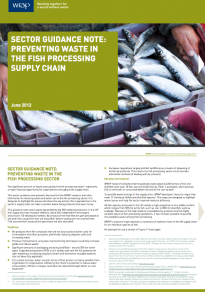Processing Plants
Fish processing plants convert fresh or frozen fish into various types of product. Processing plants can be labour intensive and or highly automated. They are used to process single or multi-species on low or large volumes depending on the capacity of the facility and availability of raw material. Both capture fisheries and aquaculture provide fish that is factory processed. Factory processing produces a variety of different products such as chilled, frozen, smoked, dried and surimi.
Typical operations inside a factory include stunning, grading, slime removal, de-heading, washing, scaling, gutting, cutting of fins, filleting, de-boning, meat bone separation, packaging and labelling. Waste is often generated during some of these operations. This waste is sometimes classed as by-products or co-products.
Fish processing facilities generate a significant amount of fish by-products (co-products) that could be an important source of energy, food, fertilizer or industrial feedstock.
The discards from the processing plants can be used to produce fish protein concentrate, fish oils and enzymes (such as pepsin and chymotrypsin), and other value-added products. The fish oil is used for products such as margarine, omega-3 fatty acids and biodiesel. The fish protein concentrate is used as human food and animal feed. Fish protein is also rich in amino acids which are highly suitable for human consumption.
Key causes of food loss and waste associated with processing plants include:
- quality deterioration
- product damage, including damage to packaging
- product outside specification or poor quality
- waste from processing operations
In the UK alone over 133,000 tonnes of fish waste, including by-products, is generated by the processing sector in total per year. This amounts to 12.7% of total inputs by weight.
Key Publications
Preventing Waste in the Fish Processing Supply Chain Included are key results from WRAP research on reducing waste and water use in fish processing, and highlights issues and key actions that supply chain organizations can take to prevent waste and save money. | |
A Village Fish Processing Plant: Yes or No? This manual gives advice about planning a fish processing plant and discusses topics and questions to consider. It focuses particularly on Alaska, USA, but is relevant to any fish processing operation. | |
A review of lipid extraction from fish processing by-product for use as a biofuel Unlike food crops, extraction of oil from fish residue does not negatively impact food production. This paper presents an overview of developments made in fish oil extraction methodologies including physical, chemical and biological processes. |
More Resources
More Resources
29 June 2024
27 February 2024
31 October 2023














